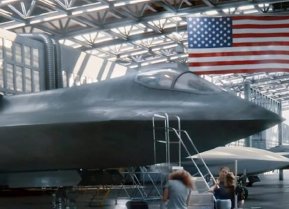U.S. Navy’s Top-Secret Manta Ray Drone Spotted on Google Maps
Last week, a Google Maps user browsing the digital globe seemed to have spotted one of the U.S. Navy’s most promising programs. A Manta Ray underwater drone prototype was spotted at the Port Hueneme Naval Base in California.
Last week, a Google Maps user browsing the digital globe seemed to have spotted one of the U.S. Navy’s most promising programs.
A Manta Ray underwater drone prototype was spotted at the Port Hueneme Naval Base in California.
The Manta Ray is one of the U.S. Navy’s most promising projects, and most of its capabilities remain classified.
The Manta Ray
The Manta Ray is an unmanned underwater system designed to provide intelligence and direct support to surface combatants and submarines. Named after the massive winged fish, the Manta Ray will serve as a long-range underwater asset for the U.S. Navy.
In terms of capabilities, the Manta Ray will bring several important skill sets. Although it is primarily designed for intelligence-gathering operations, the unmanned underwater system will be able to carry payloads to support or conduct kinetic operations. In other words, the Manta Ray won’t only be watching but also biting when there is a need.
Moreover, as an unmanned underwater system, the Manta Ray will be autonomous and won’t require any on-site human logistics. In a potential future operational environment where drones will play a considerable role, having an asset like the Manta Ray that can operate freely without much human logistical support could prove very useful in what is likely to be a very strained logistical line. For example, according to the manufacturer Northrop Grumman, the Manta Ray will be able to anchor to the seafloor and “hibernate” in a low-power state in order to conserve energy. Finally, the Manta Ray comes in a modular configuration that can be shipped and assembled quickly in expeditionary environments.
In May, the prototype of the unmanned underwater vehicle (UUV) completed its in-water testing after months of sailing off the West Coast. During the testing phase, DARPA and Northrop Grumman staff tested the Manta Ray prototype on at-sea hydrodynamic performance, including submerged operations using the drone’s modes of propulsion and steering.
“Our successful, full-scale Manta Ray testing validates the vehicle’s readiness to advance toward real-world operations after being rapidly assembled in the field from modular subsections,” Kyle Woerner, the DARPA program manager for Manta Ray, said after the successful testing.
“The combination of cross-country modular transportation, in-field assembly, and subsequent deployment demonstrates a first-of-kind capability for an extra-large UUV,” Woerner added.
“Shipping the vehicle directly to its intended area of operation conserves energy that the vehicle would otherwise expend during transit. Once deployed, the vehicle uses efficient, buoyancy-driven gliding to move through the water. The craft is designed with several payload bays of multiple sizes and types to enable a wide variety of naval mission sets,” the DARPA official added.
Given that the most pressing national security threat emanates from China, the Manta Ray project is very important for the U.S. Navy. Unlike the recent wars in the Middle East and the ongoing fighting in Ukraine, a war with China in the Indo-Pacific will focus primarily on naval and air operations. Having an unmanned underwater system that can gather intelligence and take out targets with little human supervision, like the Manta Ray promises to do, will be an invaluable asset in a potential conflict.
About the Author
Stavros Atlamazoglou is a seasoned defense journalist specializing in special operations and a Hellenic Army veteran (national service with the 575th Marine Battalion and Army HQ). He holds a BA from Johns Hopkins University and an MA from Johns Hopkins’ School of Advanced International Studies (SAIS). His work has been featured in Business Insider, Sandboxx, and SOFREP.
All images are Creative Commons.


